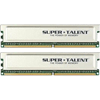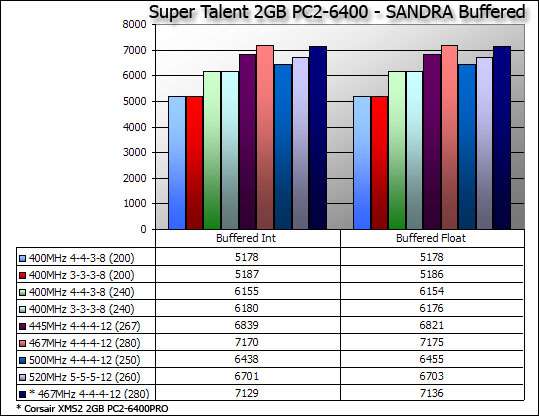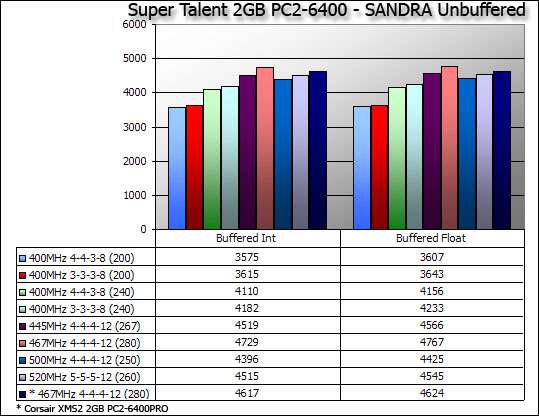- Qualcomm Launches Snapdragon 4 Gen 2 Mobile Platform
- AMD Launches Ryzen PRO 7000 Series Mobile & Desktop Platform
- Intel Launches Sleek Single-Slot Arc Pro A60 Workstation Graphics Card
- NVIDIA Announces Latest Ada Lovelace Additions: GeForce RTX 4060 Ti & RTX 4060
- Maxon Redshift With AMD Radeon GPU Rendering Support Now Available
Super Talent 2GB PC2-6400 T800UX2GC4

Most people have not even heard of Super Talent, but they are not new to the memory market. They are however new to the enthusiast side of things. It looks like they know what they are doing, because these modules are FAST. Let’s take a deep look and see just how impressive they are.
Page 4 – Testing Procedures & SANDRA
On this page, I will explain how our testing procedures go. Firstly, the hard drive that hosts the operating system is fully defragged using Diskeeper 10 to assure no hiccups will be due to the OS. All testing occurs on a standalone OS installation that’s dedicated to testing. Second, all unnecessary programs in Windows are closed down, minus the essential ones. This includes virus scanners, firewalls, peripheral software, etcetera. Before any testing occurs, the memory goes through a 4 hour MemTest run at stock settings to assure that they are error free and appropriate for overclocking and benching.
To test out the modules, I used the usual variety of benchmarking tools. No games are included in our memory benchmarking, because I consider them to be a waste of time. Overclocking your memory generally means overclocking your CPU in conjunction, which makes it hard to diagnose just what kind of difference the memory made. Here is the selection of tools we use in the review:
- Futuremark PC Mark 2005
- Lavalys EVEREST 2005
- MemTest 1.65+
- Sciencemark 2
- SiSoftware SANDRA 2005
- Super Pi 1.5 Mod
- Test System
- CPU: Pentium D 820 @ 2.8GHz
- Motherboard: ASUS P5WD2-E Premium w/ 401 BIOS
- Memory: Super Talent 2GB PC2-6400
- Video: BFG 6800GT OC 256MB PCI-E
- Sound: Realtek HD Audio
- Storage: WD 200GB 7200 8MB
- Odds and Ends: D-Link WiFi PCI Card
- Etcetera: Windows XP Professional SP2, Windows x64 Professional SP1, NVIDIA 81.98 Drivers
Throughout all of our graphs, you will see this structure: “400MHz 4-4-3-8 (200)”. The number in the parentheses is the FSB while the MHz is the frequency of the memory. Multiply that frequency by 2 and that’s how you will acquire the DDR2-800 speed.
SANDRA is by far one of the best memory benchmarking tools on the market, for numerous reasons. The first being that you can test the memory Buffered and Unbuffered, Unbuffered stressing the memory solely while leaving the CPU alone. This gives a more accurate idea of how well our memories overclock scales. In addition, when overclocking to the extreme, some benchmarking tools may escalate scores. So does SANDRA, but if your Int and Float results are very close to one another, that’s a good sign that it’s an accurate score.
If you want to know the settings we used for our Unbuffered testing, you can check out a screencap here.


These are some seriously impressive results. The Super Talent kit managed to keep right up to the Corsair kit in our buffered tests. It actually surpassed the Corsair kit in the Unbuffered tests by more than 100 MB/s. Let’s move right along to our EVEREST and Sciencemark tests.
|
|
Support our efforts! With ad revenue at an all-time low for written websites, we're relying more than ever on reader support to help us continue putting so much effort into this type of content. You can support us by becoming a Patron, or by using our Amazon shopping affiliate links listed through our articles. Thanks for your support!





